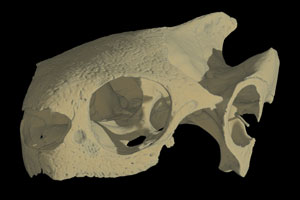Rhinoclemmys pulcherrima, the painted wood turtle, is a member of Geoemydidae within Cryptodira. There are eight species of Rhinoclemmys, and the genus is the only member of Geoemydidae to occur in the New World (Ernst and Barbour, 1989; Bonin et al., 2006). The phylogenetic position of Geoemydidae has been debated (e.g., McDowell, 1964; Hirayama, 1984; Gaffney and Meylan, 1988; Spinks et al., 2004), and the clade is currently considered to be the sister-group to Emydidae within Testudinoidea (Joyce, 2007). Geoemydidae originated in the Tertiary, and is therefore a relatively young turtle clade (Ernst and Barbour, 1989; Bonin et al., 2006).
Rhinoclemmys pulcherrima is of medium size, reaching a carapace length of up to 21.5 cm (Ernst and Barbour, 1989; Bonin et al., 2006). The skull is relatively small, short, and flattened. The carapace exhibits distinct growth annuli, a medial keel, and posterior serrations (Ernst and Barbour, 1989) . Rhinoclemmys pulcherrima has a complex head coloration, with orange to red stripes running along the midline, extending from the orbits, running along the upper and lower jaws, and on the chin. Dorsally, Rhinoclemmys pulcherrima is brown, and different subspecies may exhibit yellow or red lines, or ocelli. Ventrally, it is yellow with a dark central blotch. Forelimbs exhibit large red or yellow scales (Ernst and Barbour, 1989; Bonin et al., 2006).
. Rhinoclemmys pulcherrima has a complex head coloration, with orange to red stripes running along the midline, extending from the orbits, running along the upper and lower jaws, and on the chin. Dorsally, Rhinoclemmys pulcherrima is brown, and different subspecies may exhibit yellow or red lines, or ocelli. Ventrally, it is yellow with a dark central blotch. Forelimbs exhibit large red or yellow scales (Ernst and Barbour, 1989; Bonin et al., 2006).
Rhinoclemmys pulcherrima is a terrestrial turtle, inhabiting scrub and moist woodlands on the west coast of North and Central America, extending from Mexico to Costa Rica (Ernst and Barbour, 1989; Bonin et al., 2006). It is very active after heavy rains. Rhinoclemmys pulcherrima is omnivorous but prefers plant material. Females lay up to four clutches of three to five eggs per year (Ernst and Barbour, 1989; Bonin et al., 2006).

Literature
Beisser, C.J., Lemell, P and J. Weisgram. 2004. The dorsal lingual epithelium of Rhinoclemmys pulcherrima incisa (Chelonia, Cryptodira). Anatomical Record Part A – Discoveries in Molecular Cellular and Evolutionary Biology 277A:227-235.
Bickham, J.W. and J.L. Carr. 1983. Taxonomy and phylogeny of the higher categories of cryptodiran turtles based on a cladistic analysis of chromosomal data. Copeia 1983:918-932.
Bonin, F., Devaux, B., and A. Dupré. 2006. Turtles of the World. Translated by P.C.H. Pritchard. Johns Hopkins University Press, Baltimore MD.
Ernst, C.H. and R.W. Barbour. 1989. Turtles of the World. Smithsonian Institution Press, Washington DC.
Ferri, V. 2002. Turtles and Tortoises. Firefly Books, Willowdale, ON.
Gaffney, E.S. 1972. An illustrated glossary of turtle skull nomenclature. American Museum Novitates 2486:1-33.
Gaffney, E.S. 1979. Comparative cranial morphology of recent and fossil turtles. Bulletin of the American Museum of Natural History 164:1-376.
Gaffney, E.S. and P.A. Meylan. 1988. A phylogeny of turtles. In: Benton, M.J., editor. The Phylogeny and Classification of the Tetrapods, Volume 1: Amphibians, Reptiles, Birds. Clarendon Press, Oxford, pp. 157-219.
Hirayama, R. 1984. Cladistic analysis of batagurine turtles (Batagurinae: Emydidae: Testudinoidea); a preliminary result. Studia Geologica Salmanticensia Volume Especial 1:141-157.
Jamniczky, H.A. and A.P. Russell. 2004. A geometric morphometric assessment of the 'batagurine process' of testudinoid turtles. Amphibia-Reptilia 25:369-379.
Joyce, W.G. 2007. A phylogeny of Mesozoic turtles. Bulletin of the Peabody Museum of Natural History 48:3-102.
McDowell, S.B. 1964. Partition of the genus Clemmys and related problems in the taxonomy of aquatic Testudinidae. Proceedings of the Zoological Society of London Series B 143:239-279.
Mongenajera, J., Morera, B. and M. Chavez. 1988. Nesting behavior of Rhinoclemmys pulcherrima in Costa Rica (Testuindes, Emydidae). Herpetological Journal 1:308-308.
Orenstein, R. 2001. Turtles, Tortoises, and Terrapins: Survivors in Armor. Firefly Books, Buffalo, NY.
Pritchard, P.C.H. 1979. Encyclopedia of Turtles. TFH Publishing, Neptune FL.
Sasaki, T., Yasukawa, Y., Takahashi K., Miura, S., Shedlock, A.M. and N. Okada. 2006. Extensive morphological convergence and rapid radiation in the evolutionary history of the family Geoemydidae (old world pond turtles) revealed by SINE insertion analysis. Systematic Biology 55:912-927.
Shaffer, H.B., Meylan, P., and M.L. McKnight. 1997. Tests of turtle phylogeny: molecular, morphological, and paleontological approaches. Systematic Biology 46:235-268.
Spinks, P.Q., Shaffer, H.B., Iverson, J.B. and W.P. McCord. 2004. Phylogenetic hypotheses for the turtle family Geoemydidae. Molecular Phylogenetics and Evolution 32:164-182.










